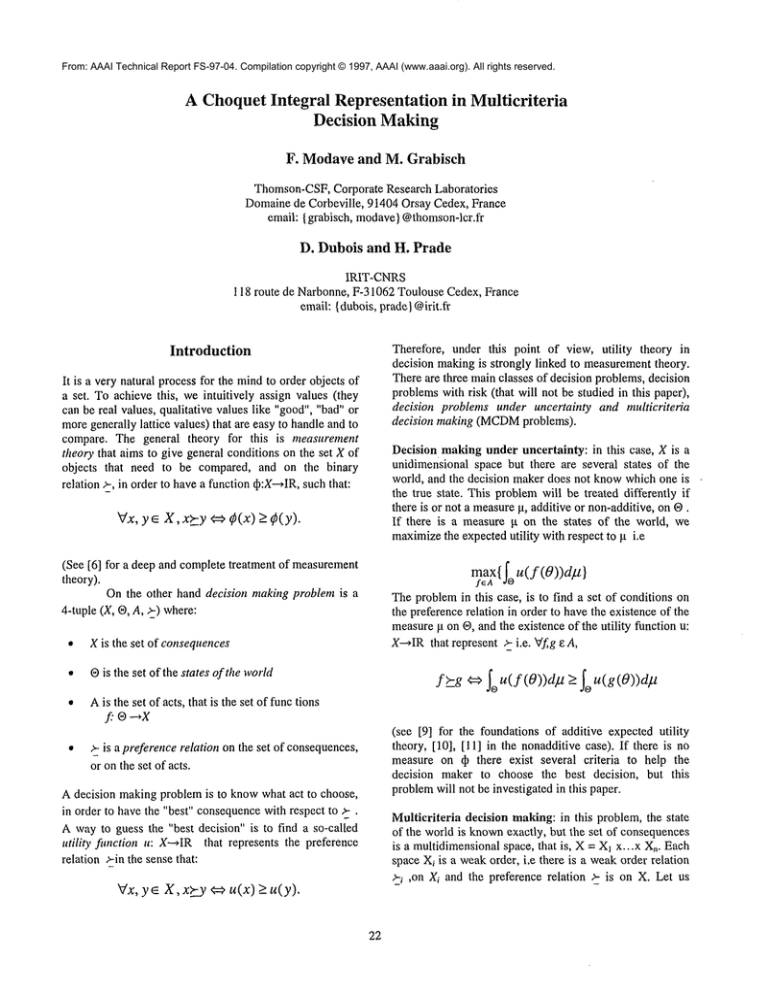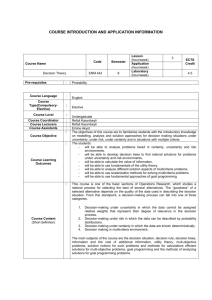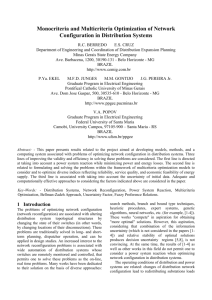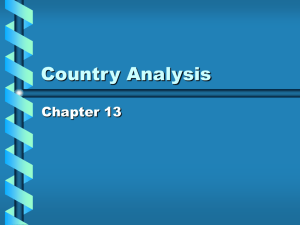
From: AAAI Technical Report FS-97-04. Compilation copyright © 1997, AAAI (www.aaai.org). All rights reserved.
A Choquet Integral
Representation in Multicriteria
Decision Making
F. Modaveand M. Grabisch
Thomson-CSF,Corporate Research Laboratories
Domainede Corbeville, 91404 Orsay Cedex, France
email: {grabisch, modave}@thomson-lcr.fr
D. Dubois and H. Prade
IRIT-CNRS
118 route de Narbonne, F-31062 Toulouse Cedex, France
email: {dubois, prade}@irit.fr
Therefore, under this point of view, utility theory in
decision makingis strongly linked to measurementtheory.
There are three mainclasses of decision problems, decision
problemswith risk (that will not be studied in this paper),
decision problems under uncertainty and multicriteria
decision making (MCDM
problems).
Introduction
It is a very natural process for the mindto order objects of
a set. To achieve this, we intuitively assign values (they
can be real values, qualitative values like "good", "bad" or
moregenerally lattice values) that are easy to handle and to
compare. The general theory for this is measurement
theory that aims to give general conditions on the set X of
objects that need to be compared, and on the binary
relation ~, in order to havea function qb:X---~IR,suchthat:
Decision makingunder uncertainty: in this case, X is a
unidimensional space but there are several states of the
world, and the decision maker does not knowwhich one is
the true state. This problemwill be treated differently if
there is or not a measurela, additive or non-additive, on ®.
If there is a measure Ix on the states of the world, we
maximizethe expected utility with respect to Ix i.e
Vx, y~ X,x>-y ¢=~ O(x) > ~(y).
(See [6] for a deep and complete treatment of measurement
theory).
On the other hand decision making problem is a
4-tuple (X, ®, A, >2) where:
¯
X is the set of consequences
¯
®is the set of the states of the world
n~ax{fou(f (O))dlt}
The problemin this case, is to find a set of conditions on
the preference relation in order to havethe existence of the
measureg on ®, and the existence of the utility function u:
X---~IRthat represent ;,- i.e. Vfg aA,
f ~g ¢=>So u(f (O))d, tt >_ So u(g(O))dfl
¯ Ais the set of acts, that is the set of func tions
f." ®---,X
;,- is a preferencerelation on the set of consequences,
or on the set of acts.
A decision makingproblem is to knowwhat act to choose,
in order to have the "best" consequencewith respect to ~-.
w
A way to guess the "best decision" is to find a so-called
utility function u: X---~IR that represents the preference
relation ~in the sense that:
(see [9] for the foundations of additive expected utility
theory, [10], [11] in the nonadditive case). If there is no
measure on qb there exist several criteria to help the
decision maker to choose the best decision, but this
problemwill not be investigated in this paper.
Multicriteria decision making: in this problem, the state
of the world is knownexactly, but the set of consequences
is a multidimensionalspace, that is, X = X1x...x Xn. Each
space Xi is a weakorder, i.e there is a weakorder relation
;L-_i ,on Xi and the preference relation ;2-_ is on X. Let us
Vx, y ~ X, x~y <=~u(x) > u(y).
22
assume that we knowthe unidimensional utility functions
ui: Xi ~ IR, for i=1 .....
n. The problem is now to
aggregate these utility functions with an appropriate
operator H, in order to represent properly the preference
relation ~, that is, find H: IRn ---~IR such that: x ~_ y is
equivalent to:
(2) if A, B ~P(g2), A C B, then, I~(A)<p(B), that is,
non decreasingset function.
Note that non-additive measures encompass probability
measures, possibility measures, belief functions, Choquet
capacities...
Let us nowgive the definitions of the Choquetintegral
and the Sugenointegral w.r.t a non-additive measure. See
[2] and [12] for the original papers.
u(x)= H(u
I (xI ) ...... u,, (x,,)) >
u(y) = H(u
I (Yl)..... ,u,, (y,,))
Definition 2 Let lz be a non-additive measureon (£2,P(g2))
andan application f: g2---~ [0, +~]. The Choquetintegral of
f w.r.t kt is defined by:
In this paper, we will denote by D, = (X, ®, A, ;,- )
decision problemunder uncertainty, and by D,, = (X, ;L-_ ),
with X = XI x...x Xn, a multicriteria decision making
problem
and I = {1 ..... n}will denotethe set of criteria.
The latest and very promisingresults in utility theory are
obtained with the use of nonadditive measures and
integrals that are better suited to deal with someaspects of
the humanbehavior (see for example [14] and [1]). This
has oriented us towards the use of the Choquetintegral as
an operator to represent the preference relation.
The AI communityhas been interested in decision with
uncertainty for a few years now but has neglected the
multicriteria aspect of decision. The aimof this paper is to
showthat, at least in the case wherethe set of states of the
world is finite, decision making with uncertainty and
multicriteria decision makingcan be viewed as the same
problems, but with different semantical interpretations.
This will, we hope, create somelinks between AI and the
multicriteria field in order to widen the scope of research
of both communities.
First, we will recall the maindefinitions and results on
non-additive measures, then we will makeclear the parallel
betweendecision makingwith uncertainty and multicriteria
decision making and eventually,
we will give a
representation or utility theoremin multicriteria decision
makingthrough the use of a Choquetintegral.
(C)f
fd~l
~-.
~ (f(x(i,)-
f(x(i_l;))/l(A(i))
i=l
wherethe subscript (.) indicates that the indices have been
permutedin order to have f (xo)) <...<
f (x(n)), A(o= {X(l)..... ,x¢,) and f(x(o) )=O by
convention.
Definition 3 Let p be a fitzzy measureon (D,P(I2)) and
application f" K2---~ [0,+~]. The Sugenointegral of f w.r.t
p is defined by:
n
(S)f f o fl =v(f(x(i) A ~l(A(i ) ))
i=l
where v is the supremum,A is the it~rnum and with the
same notations and conventions as above.
Wewill not use the Sugenointegral in this paper but we
mentionit because it is the tool we used for the qualitative
counterpart of what we present here in the uncertainty
decision case [4]. It can be seen that the Choquetintegral
and the Sugeno integral have similar construction,
respectively with the t-norm bounded sum and the tconorm X and with the t-norm A and the t-conorm v.
Nevertheless, these integrals are very different in essence.
Indeed the Choquet integral w.r.t an additive measure
reduces to the classical Lebesgueintegral but this is not
true in general for the Sugenointegral restricted to additive
measures. Besides, for applications, it seems that the
Choquet integral is better suited for superadditive or
supermodular fuzzy measures (see [3]) and the Sugeno
integral is better suited for possibility-like fuzzy measures.
Non-additive measuresand integrals
Considering the scope of our work, we will only mention
non-additive measuresand integrals in the finite case. In
this section ~ will denote a finite set, ~ = {xl ..... xn},
P(f2) the set of all subsets of g2. Wewill briefly recall the
basic definitions of non-additive integration theory that we
will need to establish our mainresult (see for example[3],
[5] or [15] for a general theory of non-additive measures
and integrals).
Definition 1 A non-additive (or fi~zzy) measure on (~2,
P(g2)) is a set fimction p: P(J2) ~ [0,1] such
Equivalence between decision makingunder
uncertainty and multicriteria
decision making
In the sequel, we will makethe hypothesis that, a decision
makingproblemunder uncertainty has a finite set of states
of the world.
(])/~(0)
23
Formal parallelism between multicriteria and
uncertainty
In classical decision theory, uncertainty and multicriteria
are treated separately, although it wouldbe very sensible to
have commonformulation and framework for both of
them.
Weconsider a decision problem under uncertainty
D. = (X, ®, A,~- ) with®={01
.... 0,,}
and a multicriteria decision making19,, = ( X,~ ), with I =
{l.....n} and X=XIX...XXn.
In D,, ,an act is a function f" (9 --*X, i.e. A = O. Since
we have assumedthat O is a finite set, we can identify the
acts with the elements of X", that is, we identify an act f
withits valuesf(01 ) ..... f(0n ). Setting,for all i = 1 ..... n,f
(Oi)=fi, weidentifyf with(/’1 .... f~ ) a vector ofX~. So, the
preference relation ;,- on the acts becomesa preference
the field of multicriteria decision makingthrough
what has been already done in uncertainty and
reciprocally.
An additive Choquet representation
in MCDM
In [4], we have presented a result of Savage giving
conditions on the preference relation of a decision problem
under uncertainty
in order to have an integral
representation with respect to an additive measure. A
property, namely the sure-thing principle, which is
equivalent to the property of mutual preferential
independenceas it is shownin [4], is responsible for the
additivity of the representation.
Let us assumethat Dm is a multicriteria decision making
problemwith Xi infinite for all i = 1 ..... n and assumeits
utility function u can be written as a Choquetintegral of
the unidimensional
utilities ui, i = 1 ..... n, with respect to a
non-additive measureg. Then, with a slight restriction on
the attributes, Murofushi in [8], [7], has shownthat the
mutual preferential independenceis also "responsible" for
the additivity of g.
In the sequel, VJ c I, V x, y ~ X, the notation (x j, yjC)
will denote the vector with coordinates equal to those of x
on J, and to those of 3’ on .P .Wewill write Xj the cartesian
product of the J-coordinates, and Xjc the cartesian product
of the jC-coordinates.
relation (that we will also denote ~- for convenience)
X":
Vf , g e A,f ~g ¢=~(f~ .......
f,,)~(gl .......
g,,)
But, in the multicriteria case, x is prefered to y will be
written
X~.~.y ~ (X1 .......
Xn )>-(Yl,"
..... Y,, )
Definition 4 Anattribute i is called essential iff
with xi, Yi c Xi ,Vi c .F
Therefore a decision problem under uncertainty can be
written in a multicriteria decision makingproblemform as
soon as we makethe following identifications:
3xi, Yi E Xi , ~,E{i},. E Xix{i}c
such that
(Xi’
X{i}c
) ~"
(Yi, xti~ ).
(1) States of the worldand criteria: 0,-~
Intuitively, an attribute i is essential iff the elementsof Xi
are not all equivalentfor the weakorder restricted to Xi.
(2) Acts and consequences: A ~ X", and
f;L’_g¢~(fl .... f,,) ;2_(gl...... g,,)
Definition 5 Let J c L Xj is said to be preferentially
htdependentw.r.t Xjc iff Vxj ,yj ~ Xj,
Remarks:
(~Xj~ E Xj~ I(xjXjc)~-(yjXjc))
Although,at least whenthe states of the world are in
finite number, an uncertainty decision problem can
always be written in a multicriteria decision making
form, the converse is not true because there is no
possible identification between XO and Xl x...xXn
(VXgc ~ Xjc,(x J ,xj~)>- (Ys ,Xjc)) (2)
If this is true for ever), J c I then the attributes are said to
be mutually preferentially independent.
whenthe sets X/are not the same which is often the
case in multicriteria decsion making. Anyway,we
will see in the next paragraphthat, if the sets X/hasa
property called order separability, it is easy to avoid
the problemand to use the results of decision under
uncertainty in multicriteria decision making.
¯
That is, the preference of xj on yj is not influenced by
other attributes. Wecan nowgive Murofushi’sresult:
Theorem1 If Dm=(X, :2-_) is a multicriteria decision
makhzg problem, if we assume that there exists a nonadditive measurekt on 2t such that the utility function u can
be written:
This could certainly lead, to some extent, to
interesting investigations of Artificial Intelligence in
24
u( x) ~ [ U) ( x(i) ) - u ¢i_l) ( x¢i_l) ) ]/z (
(3)
(CH) Weshall assumethat there exists a weak order &
Ui~l Xi given by the decision makerand Vi, j ~ I, if there
exist xi ~ Xi and xj ~ X] suchthat ~Pi (xi) >~pj (xj) (resp. <
resp. =), then it does meanthat the decision makerxi to xj
(resp. xj to xi ,resp. xi andxj are equivalent).
i=1
where the ui ’s are the unidimensional utilities, and if
atleast there are 3 essential attributes, then we have the
following equivalence:
Besides, we shall assume that the weak orders are total
orders. This is not restrictive since we knowthat if X is a
set and ~ a weakorder, then ~- is a total order on X/-,
were - is the equivalence relation derived from >- . Note
that this hypothesis implies that the ~bl’s are injective.
Therefore, in the sequel, an ordered set will denote a set
with a total order.
Wenowgive the definitions and hypothesis to prove our
main result. The definitions here are strict adaptations of
the original definitions in [13] in order to be able to apply
them to multicriteria decision making or decision with
uncertainty. To be self-contained, we first recall a few
useful topological definitions.
(1) the attributes are mutuallypreferentially
independent
(2) I-t is an additive measure
This result enhances the parallel betweenD, and/9,, since
in both theories, an equivalent property, at least in the
integral representation case, is responsible for the
additivity.
A Choquet
representation
theorem for
decision making
As we have seen in the above paragraph, if Dmhas a
Choquetrepresentation, we knowif it is additive or not.
Yet, there is no theorem giving conditions on the
preference relation in the multicriteria decision making
problem case, in order to have a Choquet integral
representation. Nevertheless, P.Wakkerin [13] has proven
a Choquetintegral representation result in the decision
with uncertainty case. Usingthe parallel explained in the
above section, and adapting Wakker’sresult, we will show
that it is rather easy to get a Choquet integral
representation result in multicriteria decision making
theory.
Definition 7 Let X be a set and T a subset of P(X). T
called a topologyof X iff
(ii) if(U, ,), ~ A is a familyof elementsoff then
U,~AU~ ~ T
(iii)
(F.)aea E
is a finite family of elementsof T then
Wefirst recall an importantresult of representation in [6].
Definition 6 Let (X, ~ be a set with a weakorder relation.
A subset of X, A is said to be order dense w.r.t >- ifffor
all x,y e X, x >- y,there exists a e Asuch that x ~ a ~ y. X
is said to be order separable iff there exists an order
dense, at most countable subset of X.
The elements of T are called the open sets of the topology
and their complementary sets in X are called the closed
sets in X. (X,T) is called a topological space.
Definition 8 Let (X,T) be a topological space. It &called
connected topological space if the only sets that are both
open and closed are X and f3. This is equivalent to say that
a fimetionf" X--~{0,1} is continuousiff it is constant.
Then, we have the following theorem:
Theorem2 Let (X, ;,- ) be a set with a weak order, then
there exists an application qb : X ----> IR such that k/x,y~X,
x ;L-_ Y¢:¢’¢(x) > ¢0’) iff X is orderseparable.
See [6] for a proof.
In the sequel, wewill assume,that, for all i e I, the weak
orderedset (Xi, ;’-i ) is order separableand therefore admits
a real-valued representation denoted by qbi.We will make
the following commensurabilityhypothesis.
25
Definition 9 Let (X,T) be a topological space. It is called
separable if there exists Ae X such that A & at most
countable and‘4 = X where .4 denotes the closure of A that
is, the smallest closed set whose complementaryset in X
(that is an open set) does not intersect A (A is said to
dense in X).
Definition 10 Let (X,:,-)be
an ordered set, and X
-l
endowed with a topology. ~ is said to be a continuous
order if for all a e X, the sets Ix e XIx >- a} and Ix e Xla
x} are opensets.
(×iv’
>_
(°O)_(Yi~,
(yi ~, (ki-’
Definition11Let Xt, ..... X, be n orderedsets with ~1...... >-_,
their respective ordersand¢Pl ..... dp, their respective realvalued representation, satisfying the previous hypotheses.
A subset A c X = Xl × ... x X, is said to be comonotonic
if for all i, jE 1, for all x, y e A wehave:
¢i(Xi)>--¢j(Xj)==~¢i(Yi)>--~j(yj)
~i
(8))]>"(Xic,
-i
~)i
(fl))and
~?1 (~/))
In the original definition of Wakker,a, fl,~,,c~ werein a
unidimensional space X. To extend it to the multicriteria
case, it is necessaryto use the ~ transformsin order to have
a, fl,?,c~ in the sameset.
Definition 13 With the same notations as above, ~ the
order relation of X reveals comonotonic contradictory
tradeoffsif there exist a, fl, y,~ e f’l i~ I I mfbi suchthat:
(4)
(a, fi)~ (~, 6)and(l, 6) >-c (a,
Note that, ifXi = Xj for all i,j e I, we get the usual
definition of a comonotonicset.
Wegive the following exampleto understand intuitively
the notion of comonotonicity.
Example:
Example:
Let us consider a decision problem involving cars,
evaluated on two criteria, the cost c and the performance
p. Let us imaginethe following four cars:
Let us assume that a consumerwants to buy a new car.
His criteria are the price p, the speeds, the color c, the gas
g. The set of possible choices are a Ferrari, 5 Renault
cars, 5 Peugeot cars. Wecan nowassume, that the set of
Renault cars constitute a comonotonicset of his possible
choices. The consumercan say that if a criterion is better
satisfied than an other for one Renault car, this will be
true for the other Renault cars. To do this, the consumer
must put "mentally" the criteria on the same scale of
satisfaction in order to comparethem, since obviously, he
can not a priori comparethe price to the color.
Car A (c=20000,p=100)
Car B (c=22000, p=110)
Car C (c=20000, p=130)
Car D (c=22000,p=160)
And suppose that the decision maker wants a powerful
car at a lowcost. This meansthat the functions ~,. and d~
t,
are respectively decreasing with c and increasing with p.
Suppose that the decision maker has the following
preference:
A =(20000,100);,-
Wenowintroduce two order relations and the notion of
contradictory comonotonictradeoffs.
B=(22000,110)
The reason may be that, since for A and B the
performanceis rather low w.r.t cost, it does not worth to
buy B, and the cheapest car is preferred.
Definition12 Let ct,[3,7,~i e f’l i~ i I m(~~ whichis not empty
since our commensurabilityassumption. Wewill write
(a,f~)>-c (~,8)
Nowsuppose that
if there exist i 8 1 and{(xic,~il(a)),( yie,qsi-1([3)),( -l
(T)),)’ic,~bi l (~5))} a comonotonic
set of X, such that:
C=(20000,130) -<_ D=(22000,160)
In this case, since the performance is muchhigher than
the average, the decision makeraccepts the rather small
difference of cost to have the most powerfulcar.
( x i~, (b?’( a’))>-(y i~(/).’ (fl) )a
(y,~,q~,.-’(~))>-(x,~,q~,.-’(7"))
(7)
(5)
In a second step, four other cars are proposed to the
decision maker, whichare:
And, we will write
(a,13)tc (-:,8)
car
car
car
car
if there exist i e I and {(xic,c~il(lx)),(
yic,cPi -I -1
(~)),( xic,(J~i
(y)), yic,(Pi "1 (6))} a comonotonic
set of X, such that:
26
A’ (c
B’ (c
C’ (c
D’ (c
= 10000,p = 130)
= 15000,p = 160)
= 10000,p = 100)
= 15000,p = 110)
and we suppose that the decision makerhas the following
preference
Theorem3 Let X be a topological, connected, separable
space and a binary relation ~ defined on X# . Let I =
{1.....n}. Then, the following assertions are equivalent:
A’= (10000,130) ;L2 B’= (15000,160)
C’=(10000,100) -< D’=(15000,110).
(1) there exists a non-additive measure g
continuousfunction u: X -->IR such that
VXi , Yi ~ X, Vi =1 ..... n
This preference can be explained as follows. It is very
unusual to have a car which is both very powerful and
very cheap, as A’, so that A’ is prefered to B’. Onthe other
hand, as both C’ and D’ are cheap cars, the decision maker
prefers D’, since for a small difference of cost, he/she can
get a more powerfulcar.
is equivalent to
A decision maker having this preference exhibits a
comonotoniccontradictory tradeoff for ct,13,),,~i since
letting A = (x, a), B=(y,fl), C=(x,T),D=(y,~)A-(x’,~),
B ’=0",6), C -(x’,ct), D ’=0,’,13) we have simultaneously:
(x~.... .x.):2-_0’1.....y.)
ZT=l [b/(X(i)
Z]:I
(8)
) -- L/(X(i_I ) )](~/~(i)
[u(Y(i,
) --
)
u( y (~_,, )](~(i,
(2) is a c ontinuous ord er, tha t doe s
comonotoniccontradictory tradeoffs.
(x,a)~ (y,~)and(x,7)~(y,6)
and a
on 21,
(9)
not reveal
Wewill nowprove the following:
and
Theorem4 Assume Xb ..... X,, are topological connected
separable spaces, with preferencerelations ~ i ,i =1.... n,
that are continuous orders. Let ~ be a binary relation on
(x’, a) -< (y’, fJ )and(x’,7 )~(Y’,
as figure (1) shows.
This definition is a straightforward extension of Wakker’s
definition of comonotoniccontradictory tradeoffs, but, our
definition which reduces to Wakker’sdefinition if all the
Xi’s are identical has the advantageto allow us to deal with
a multicriteria decision makingproblem or a problem of
decision with uncertainty. For the convenience of the
reader, we recall Wakker’sresult in the D,, case.
X = Xl ×..× Xn. Assumethat for each i =l, .... n, Im~Oi=IR.
Then, we have the following equivalence:
(1) there exist a non-additive measure g on 21 and n
continuousfimctions ui: Xi --->IR, i~ I, suchthat:
x =(xI ...... x,, )~__y
=(3’~...... y,, )
is equivalentto:
Z]=I [U(i)
x’
(X(i)
) U(i_I ) (X( i_I)
)]/.Z (A(
i)) _>
8
ZT:I
...."
..,#
yt
(10)
[b/(i)(Y(i))
-- U(i-I)(Y(i-1))]/./(A(i))
(11)
(2) is a c ontinuous ord er, tha t doe s not reve al
comonotoniccontradictory tradeoffs.
...,"
Proof: (1) ~ (2) is very similar to the proof given
Wakkerin [13] and therefore omitted. Wewill prove the
interesting part of the theorem, that is on what conditions
on the preference relation, we have a Choquet integral
representation. (2) ~ (1):
.........,..,..."""’’.... J"
X ...’’"’"
..""
-::......................
:/:"..
.........
....."
.."
/-"
Lemma
1 Vi~ I,
Figure 1: Possible exampleof a preference relation with
comonotoniccontradictory tradeoffs
(~i
is a continuous function from Xi to IR.
Proof: Let i ~ I and ]a, b[ an open interval of IR. ~i -1
(]a,b[) {xi ~ Xi[dp i-l(a) >- xi >- ?Pi-1(b) which is an open
set using the hypothesisof continuity of the order ~ i.
27
-1
,
-1
-1
,
-I
Wenowintroduce a new order on IR" =q~,(X,) X...xG(X.).
(x f ~bj (O0)>-(yf (fl) and
Definition 14 The binary relation ~-’ on qbl(Xi) X...Xd~.(X.)
is defined by:
(y f ~bj (6))~(x ./~ ~bj
(Y,)....... ,4,, (Y,,))
¢:>(x, ........ x,, )>-(y~
........ y. )
(41 (Xl)’" .....
(16)
that is >-reveals comonotoniccontradictory tradeoffs which
is contrary to our assumptions.Therefore, >-’ doesn’t reveal
comonotoniccontradictory tradeoffs.
’ ~n (Xn))]>-’(~1
(12)
Now,we knowthat ?pi(Xi) = IR is a connected separable
topological space for all i ~ L >-’ is a continuous order
It is very easy to see that the above binary relation is an
order relation on qbl(Xi)X...×qbn(X,,)since ~ is an order.
Lemma2 ;,-’
,
relation on IR" = dh(Xl) x...xqb~(X,) that doesn’t reveal
comonotonic contradictory tradeoffs. Using Wakker’s
theorem, there exist a non-additive measure g on 21 and a
continuousfunction u: IR ----> IR such that:
is a continuous weak order on IR" = dh(X1)
×... xqb,,(X,)for the usual topolopyoflR".
(~b~(x~),...... , ~. (x,, ))>-’(~bl(y, ),. ..... ,~.(y.))
Proof: Since > is a continuous order Oi"1 is a continuous
function from IR to Xi for all i e I by lemma(1). But
(17)
is equivalentto
{(qbl(xl)..... qb.(x.))>-’ (qbl(al)..... qb.(a.))}=dpi({Xl
(xl .... ,x.) >- (al ..... a.)} which is open since ~[1
continuous. Therefore ~ ’ is continuous.
~7=~
[u(~b~i)
( x(i))) - u(O~i-,)( x(i_,)(A
~i)) >
Lemma 3 ;.-’ doesn’t reveal comonotoniccontradictory
tradeoffs.
ZT=I ["(~(i)(Y(i)))-
U(~(i-l,
(18)
(y(~_,)))]/z(A,,,)
Usingthe definition of ,~" and defining for all i ~ I, ui: X~
IR by ui = uod?i whichare continuous functions since u
is continuous according to Wakker’stheoremand the qbi’s
are continuous by lemma(2), we get
Proof: Assumethe contrary, there exist cq13,%~5~ IR such
that (o~,13) ~ ’c (7,5) and (7,6) ~ ’c (oql3). So, there
ie I and{ ( ~,, (x ,,.),7), ( g0,*"(Y,*’)’~)’( qb,~:(x i¢),0t),
,,.),13)} a comonotonic
set suchthat:
(x~.....x.)~(y~..... y.)
(19)
is equivalentto:
(13)
ZT=l [U(i)
Andthere exist j ~ I and {( qbf (x~),7), ( ¢. 0"F),5), ( q
(x f),cO, ( ~¢. ¢-),13)} a com
onotonic setsuchthat:
ZT=I[b/-(i)
(yicOi -1 (/3))
-I
)]/z(A~i)
) >
(Y(i)) b/Q-l) (Y(i-I))]/t(A(/) )
(20)
In this paper, we have shown the strong parallelism
between decision under uncertainty
problems and
multicriteria decision making. This has permitted us to
generalize a Choquetintegral representation result to the
multicriteria case, result that was lacking until now. Our
future work will consist in generalizing, with the method
explained in this article, other representation results of
decision under uncertainty to MCDM
problems. Besides,
we have assumed in our paper that the sets of
consequenceswere infinite. Indeed Krantz et al. in [6] have
(6)and
~- (Xic~)i -I (0~)
) (X(i_I)
Conclusion
(14)
((bf (y’f ), (~)~’c (Oj~(X’f 7’)
Using the definition of ~-’ we get that equation (13)
equivalent to:
(7"))~(yi~Oi
) --/g(i_l
Andthis completes the proof.
(hi (x f ),cO~(~)f (y f ),fl)and
Xi¢ ~)i-I
(X(i)
(15)
and equation (14) is equivalent to:
28
shown that the hypotheses assumed to have an additive
representation in the infinite case were not sufficient in the
finite case. Therefore, we need to extend our work to the
finite case since it is essential in practical situations.
References
1.
2.
3.
4.
5.
6.
7.
8.
9.
10.
11.
12.
13.
14.
15.
A. Chateauneuf. Ellsberg paradox intuition and
choquet expected utility. In G. Coletti, D. Dubois, and
R. Scozzafava, editors, Mathematical models for
handling partial knolwledgein artificial intelligence,
pages 1-20. PlenumPress, 1995.
G. Choquet. Theory of Capacities. Ann. Inst. Fourier
5, 1954.
D. Denneberg. Non-Additive Measure and hztegral.
Kluwer AcademicPublisher, 1994.
D. Dubois, M. Grabisch, F. Modave,and H. Prade. Un
parall~le entre d6cision dans l’incertain et d6cision
multicrit~re dans une perspective IA. bz Actes de cot~
Rep. Formeset Intel. Art., Clermont-Ferrand,Janvier
1998.
M. Grabisch, H. T. Nguyen, and E. A. Walker.
Fundamentals of Uncertahzty
Calculi with
Applications to Fuzz), hzference. Kluwer Academic
Publisher, Dordrecht, 1995.
D. Krantz, R. Luce, P. Suppes, and A. Tverski.
Foundations of Measurement.AcademicPress, 1971.
T. Murofushi and M. Sugeno. An interpretation
of
fuzzy measureand the Cboquetintegral as an integral
with respect to a fuzzy measure. Fuzzy Sets &Systems,
29:201-227, 1989.
T. Murofushi and M. Sugeno. Fuzzy t-conorm
integrals
with respect to fuzzy measures:
generalization
of Sugeno integral and Choquet
integral. Fuzzy Sets &S),stems, 42:57-71, 1991.
L.J. Savage. The Foundations of Statistics. Dover, 2
edition, 1972.
D. Schmeidler. Integral representation
without
additivity. Proc. of the Amer. Math. Soc., 97(2):255261, 1986.
D. Schmeidler. Subjective probability and expected
utility without additivity. Econometrica, 57(3):571587, 1989.
M. Sugeno. Theory of fiLzzy integrals and its
applications. PhDthesis, TokyoInst. of Technology,
1974.
P. Wakker. Additive Representations of Preferences.
Kluwer AcademicPublishers, 1989.
P. Wakker. A behavioral foundation for fuzzy
measures. Fuzzy Sets &Systems, 37:327-350, 1990.
Z. Wangand G.J. Klir. Fuzzy measuretheory. Plenum,
1992.
29








